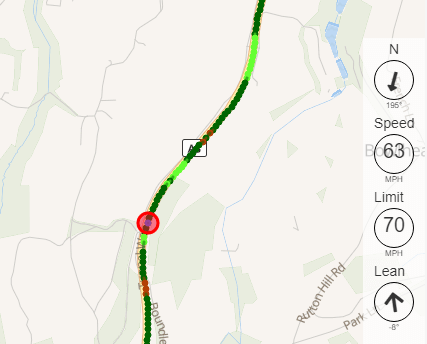If you ride a motorcycle you'll know that feeling when you go round a corner and the bike just feels awesome, you want to tell everyone in your group how good it felt and you end up with a big smile on your face. Part of that feeling is due to the bike being perfectly in balance and that's because your lean angle has equalled out the forces acting on the bike during the corner.
We've added a new feature specifically for bikers to help understand the dynamics of cornering and you can now see our calculated lean angle throughout your trip on the trip detail page, we show the lean for each GPS point in the map and you can scroll through the trip data using the timeline to see how you rode through any curve on your trip.
through any curve on your trip.
We've also updated the trip page to provide detailed plot of lean angles through the entire trip, simply click this overview and you'll be taken to the exact GPS location on the main map so you can see more detail, we've even included your max left and right angles and made them clickable too!

How do we calculate the lean angle?
We use a blend of the sensors contained in the tracker along with your GPS speed and our knowledge of the road network to work out the bend radius and then apply some physics equations to calculate the expected lean of the bike, but to do this we do have to make some assumptions:
- The motorcycle speed is steady throughout the curve
- The rider leans at the same angle as the bike
- The section of the tyre in contact with the road remains the same when leaned over
These assumptions allow us to simplify the maths involved and under test conditions, we've found that actual lean angles can be a little larger than our estimates particularly on sportier bikes with fatter tyres and more experienced riders, in we generally UNDER estimate the angle actually achieved by the rider. In other words, our angles should be treated as an 'at least' value rather than the absolute value for higher performance bikes & riders.
Why is this useful?
The calculated lean angle is used to work out how aggressively riders are cornering, we use this data as part of our driver/rider feedback systems as one measure of how aggressively the bike is being ridden, these numbers are also of interest to motorcycle riders that want to improve their riding skills and optimize their riding technique.
As a guide to lean angles, we have found that different classes of bikes are capable of different max lean angles in normal road riding, so our guide below will help you see how you are performing (track riding will produce significantly higher values!):
- Learner bikes: Around 20º
- Cruiser / Adventure bikes: Around 30º
- Sport bikes: Around 50º or more
We hope you like this feature and please make sure you give us some feedback on how you find it!

